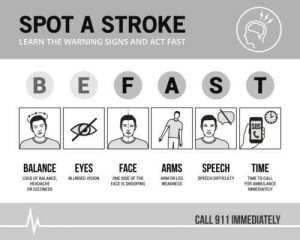
Research shows that close to 800,000 Americans have a stroke every year. About 140,000 die from it. It’s estimated that one out of every 20 deaths in the United States can be linked to this brain-damaging condition.
Of course, stroke prevention is the best approach to lower the statistics, but the problem will always exist. Still, medical experts say the number of deaths and the number of people suffering significant health damage would be lower if we all could spot the warning signs of stroke.
What is a stroke?
A stroke happens when the blood to the brain is cut off or reduced. The brain can’t get the required oxygen and nutrients. As a result, brain cells start to die. When brain cells die and stroke occurs, both physical and mental abilities controlled by the brain, including muscle and memory control, can be lost.
After a stroke, a person can be left with impaired judgement, impaired mobility, perception difficulty, unusual emotions, significant speech impairment, memory loss, and problems from neglecting the affected side of the body. Depending on the area of the brain that is affected, the impairment can be mild or severe.
Signs of stroke in women and men
Signs of a stroke in men and women may slightly differ, but there are some general common symptoms that occur in both genders. Unfortunately, many men are less aware of the signs and symptoms of a stroke, compared to women, which increases their risk of resulting complications. Therefore, it’s important to recognize the signs and symptoms that are listed below.
- Sudden confusion or trouble speaking
- Numbness or weakness of face, arm, and/or leg
- Trouble seeing
- Sudden trouble walking, dizziness, and/or loss of balance
- Severe headache
Think FAST to spot a stroke
Communication experts say that close to 90 percent of what we say comes from non-verbal cues. In other words, our body language can tell people a lot. Spotting a stroke is like reading body language.
The American Stroke Association says that we have to think and react fast if we want to catch a stroke. The letters F-A-S-T represent the key warning signs that someone could be having a stroke:
F — stands for one side of the person’s Face dropping. It could be numb. Ask the person to smile and see if they have an uneven smile.
A – ask the person to raise both Arms. If one arm is weak or one arm drifts downward, this is a sign.
S – is the person’s Speech slurred? Can they speak at all?
T – it is Time to call 911 if any of these symptoms occur. You should also check the Time so you know when the signs started to happen.
Some stroke sufferers will complain about other symptoms such as blurred or blackened vision, as well as headache, dizziness or altered consciousness. Stumbling and loss of balance can also be an early sign.
Keys to stroke prevention
Genetics can play a role in stroke. However, just because a family member suffered a stroke does not mean you will have a stroke. It can mean that you might be at a higher risk for having one than a person who does not have a family history of stroke.
Your doctor can help you assess your lifestyle to reduce the risk factors. Medical professionals agree that prevention is the key when it comes to avoiding stroke.
Here are some things you can do to avoid falling victim of a brain attack:
- Maintain a healthy blood pressure. According to Harvard Health, high blood pressure is the biggest contributor to the risk of stroke.
- Lose some weight. If you have a few extra pounds, it turns out that losing as little as 10 can lower your stroke risk.
- Exercise more. Studies show women who walk three hours a week are less likely to suffer a stroke.
- Drink in moderation. Once you start drinking more than two drinks per day, your risk goes up. Studies show, red wine should be your first drink of choice when it comes to alcohol because it has brain-protecting properties.
- Quit smoking. Smoking increases clot formation.
- Treat diabetes. High blood sugar over time can damage blood vessels, causing clots to form.
Having a stroke can be life altering, not only for the patient, but for family members as well. In many cases, all aspects of life – social, physical, emotional, financial – are thrown upside down when someone has a stroke.
It’s a hard road to travel, but consider how easy it is to keep a FAST list as a reminder on your fridge or in your wallet. Spotting a stroke early and getting them to the emergency room quickly could be vital to survival and determining what quality of life the person will have following rehabilitation.